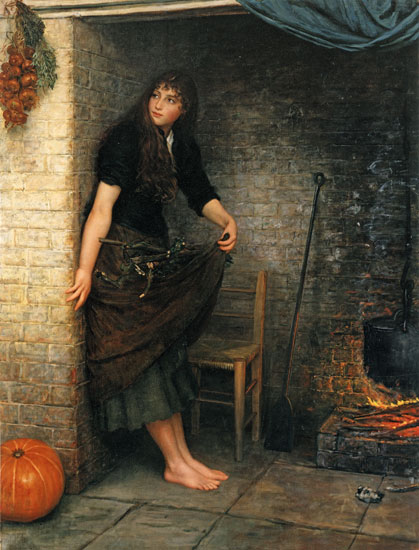8 ♦ Ashputtle
 ...also known as Cinderella!
...also known as Cinderella!I promise I shuffled the cards very, very well at the beginning of this challenge, and yet here we have another fairytale. Not that I'm complaining. (And besides, random selection is unlikely to be uniform.) I already know my next card - and rest assured! it's not a diamond.
The Grimm fairytales are an altogether different assortment than Andersen. For one thing, the Grimm brothers were primarily collectors, scholars, and editors, not inventors of original tales. There is decidedly less poetry in their stories. The style is terse and upfront, making these plots fast-paced and very short. "Ashputtle" is no exception.
Once again, I was unsettled by the violence - and, well, mutilation - found in an otherwise familiar setting. There was no modern feeling of concern in Ashputtle's marrying a stranger, since she could hardly do worse than her own family. Even her father, alive in this version, appears to disown her; he is quick to marry again and also begins to think of her as a servant. I don't know...I guess it was a happy ending (?!).
It was interesting how logistics were handled in this story. The narrator is so careful to explain how Ashputtle could have gone to the ball in her beautiful gown and come back in time to change back into her old dress. Yet other facts (the origins of the family dysfunction, for one) are completely glossed over. I suppose that is more characteristic of what a child's questions would be, as opposed to an adult's.
I've read a few other Grimm stories before this one, and I can say that the difference between the "dark" aspects of Grimm versus those of Andersen are the way they are presented. Andersen takes his stories pretty seriously and wants the reader to do the same. Grimms' stories are almost tongue-in-cheek, self-consciously shocking, and effectively dark humor. I'll bet that was more for the storyteller's benefit than the children's...
3 stars.
Wait - I ought to mention Hawthorne, since his mythology came first. He would certainly not have written something so dark as "Ashputtle," and I think that - dare I say it - his distinctly American type of realism would not have come up with a moral as convoluted as the one in "The Little Mermaid." The trade-off is that while I can rate "The Golden Fleece" higher, these other two are vastly more memorable.
To a degree, it may be unfair to compare them exactly. A mythology should be a bit grand, and a fairytale at least a little weird. Still, these were all written for children, and I think there is something to get out of each of them, as different as they are.



Comments
I've been surprised at how unsettling even some more modern children's books are. The Wizard of Oz comes to mind, and I'm reading Pinocchio now and it's not a lovely little children's book. Feet getting burnt off, hangings, etc. Yikes! Children must have been much more resilient than now. With the popularity of these books, I'm sure people of those times would wonder what we're all fussing about!